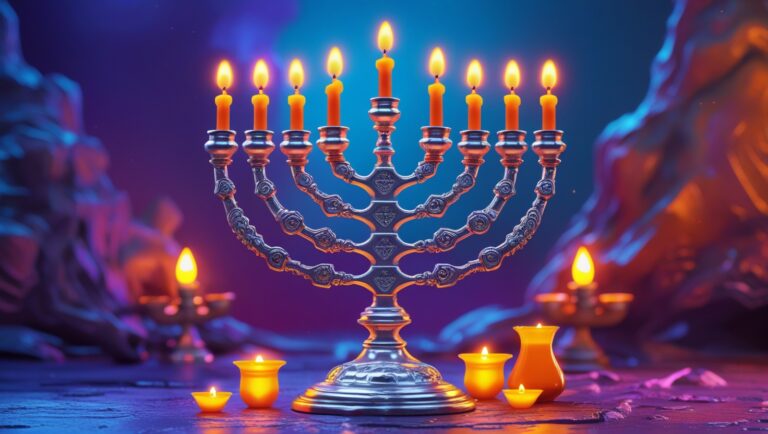Let’s explore a topic few people give consideration: witchcraft and evil eye
I used to be skeptical about all woo-woo things. I never thought of them to be anything but some vague wishful thinking with no power. But I changed my mind as I slowly began to understand a little about the mechanisms of Creation and the unifying principle of energy.
When we understand a little about how things manifest in the physical world, then we begin to realize how it was possible for Rabbi Chaim Vital to be bedridden for 9 months after his wedding because his wife “cast a spell” on him. Or how Shimon Ben Shatach averted the destruction of the world by 80 witches as we find in Massechet Chaguiga from Talmud Yerushalmi and Sanhedrin from the Bavli.
Well, as one might imagine, energy can be manipulated and that’s what we might call “magic”. Or “technology”, depending on whether we are internally or externally manipulating it. And one would be surprised to see how much of Kabbalah literature is devoted to writing Kameot or pronouncing God’s holy names to neutralize the forces of witchcraft and the evil eye.
The Ben Ish Chai gives a very interesting ritual in which one takes an egg and recites a prayer to bind the evil eye (and its spirits) with an oath to leave the host, upon whom the egg is waved above his head. It works.
But let’s delve a little more deeply into how witchcraft and the evil eye operate so we can protect ourselves.
The rise of idol worship
If we want to understand witchcraft, why not go to its hot-bead of ancient Egypt?
Witchcraft has been a part of human history for millennia, intertwining with the beliefs and practices of many ancient cultures. particularly in Egypt, where it held a significant role. In ancient Egypt, magic was deeply respected and seen as a necessary force for everyday life. The Egyptian word for magic, “heka,” was considered a divine power granted by the gods to priests and magicians. Far from being feared, witches and magicians were often consulted to solve personal and communal problems, ranging from protection against diseases to blessings for childbirth.
Now, when we say “gods” we obviously don’t mean to equate, chas v’shalom, the lower-strata creatures of the spiritual worlds of Beriyah, Yetzirah and Assiyah with Hashem who, alone, created all the spiritual and physical worlds. In Pirkei Avot 5:6 and Bereshit Rabba, the sages teach that during the 6th day of Creation, many demons were left unfinished, and they inhabit these lower realms, being able to give guidance, power and blessings to those who serve them.
See, the ancients were not stupid to do the “rain dance” during rainy season, or to make an offering to the “volcano god” and not verify whether there was a substantial positive change in their lives or not. They knew very well these were spiritual creatures that Hashem appointed to oversee Creation, and imparted some of His power to them to cause tacit change in the physical realm.
They are real, and could be contacted by the meditators/priests/elders who could enter a state of trance and get answers. All these “gods” from ancient cultures such as the Egyptian, Greek, Roman, Nord, Chinese, Mayan, Hindu and so on exist, and have some power (from Hashem) to affect reality. Which is why it’s a wonder to me why many rabbis consider speaking the names of these gods not forbidden since they are very much worshipped to this day.
Of course, serving these spirits in any of the 4 formal ways of worship is strictly forbidden by Halacha. They are: sacrificing an animal, libation, offering incense and prostrating. Calling the idol one’s “god” or serving him in his unique mode of service are 2 more ways one violates the commandment against idol worshipping.
The deeper reason is simple to understand: any of these forms of service establishes a bond of servitude between the person and the spirit something which Hashem hates. Yet, the spiritual energy of the the offering ends up pleasing and empowering the spirit, which in turn may reward the person (i.e. sinner) doing so.
We serve Hashem, only. Yet there have been instances when the sages contacted demons to get their help (without offering anything).
We all know that this started with the generation of Enosh when people began worshipping the celestial bodies. While they were wicked and merely looking for a pretext to “justify” their evil, they knew fully well what they were doing.
Binding demons in witchcraft
Our sages (Sanhedrin 67b) teach that the sorcerers of ancient Egypt could not replicate the 3rd plague of lice from Moshe Rabbenu because “they are smaller than a lentil, and demons could only create something bigger than that”. From here we learn that a lot of witchcraft comes through the agency of demons. But not all of it.
Spirits are a form of organized, sentient energy which can be harnessed. Some rituals involve using the voluntary cooperation of a demon, while others force them to perform certain actions.
Many Kabbalah books teach one how to bind demons and angels to do one’s bidding. This is an incredibly dangerous practice which should be avoided at all costs. Arguably, demons could pose less of a problem since they are evil by default. Angels on the other hand could exact vengeance upon one who utters the Holy Names of God to make wonders, even for the sake of Heaven.
One needs to be at an incredibly high level to use holy names of Hashem and not get harmed. Among the conditions Rav Kaduri writes in his book about Kameot and Divine Names called Kedushat Yitzhak is that one must know how to unify the spiritual worlds, be an outstanding Tzadik, have no desire for honor (i.e. do it entirely for the sake of Heaven), be a great scholar, have tremendous fear of Heaven, among other things. Even so one can be harmed by the angel in charge of the specific Holy Name he’s uttering.
Yet, the ancients knew of this technology of the mind to manipulate energy and many didn’t need to bind demons or angels for that.
What is the Evil Eye about?
As we learned in many articles before, we are constantly interacting with the spiritual worlds, exchanging energy. The higher parts of our soul are very much manifest there and everything we think, speak and do cause an impression there.
It might sound silly or simply wishful thinking, but our thoughts have power. We are immersed in a sea of spiritual energy, in which the slightest fluctuation in our psyches causes ripples in Creation. As the Zohar writes, each person has 3 modes (or vestments) for expressing his soul: Thoughts, Speech and Action.
Thoughts are more ethereal, and weak to affect the physical realm.
Speech has some tangible manifestation and has more force.
Action is the most physical but also the most powerful to effect change.
It’s interesting to note that in Halacha, speech is not considered pushable by the court since it is not considered an “action”, but it is punishable by the Heavenly Court. Either way, when uniting all these elements in the service of God, then the Mitzvah or study of Torah is that much more powerful. What might sound like a simple act by a Tzadik, could be changing the entire course of history. Sadly, the opposite is also true. Part of actualizing this power is actually believing that this power is already within us and could be trained.
There is actually a deeper level than thought, which in Kabbalah is called Umka D’Libah (lit. The Depths of the Heart), which is essentially the power of the will.
When one unites all these powers, he can direct them simply by using the evil eye.
The concept of “as above, so below” is fundamental in Kabbalah. Actions in the spiritual realms (such as directing negative thoughts or speech toward another person) resonate in the physical world. The Evil Eye can disrupt the spiritual pathways that usually bring blessings, health, and prosperity into someone’s life. When these pathways are blocked or filled with harmful energy, it manifests as physical misfortune, such as illness, financial loss, or emotional distress.
In this framework, the Evil Eye essentially weaponizes human consciousness, using the interconnected forces of thought, speech, and action to influence both the spiritual and material worlds. It is real and operates more or less on the same principles as witchcraft.
The eye, as the center of consciousness for most people, acts as a direct bridge to the soul, making malicious intent radiate and affect a person. Sure, at first glance (no pun intended), nothing seems to happen, but the real effect comes after the caster puts his eye on the target, affecting his psyche and even higher parts of the soul.
To be fair, this is very rare, but is not impossible. One of the spiritual principles of Creation is that the effects of emotional and spiritual states add up over time. This means that many people with obsessions with others can indeed, consciously or not, affect the person.
Protection Against the Evil Eye and Witchcraft
Jewish tradition offers various remedies and protections against the Evil Eye, which are grounded in spiritual principles. One common method is to guard one’s blessings by avoiding public displays of excessive wealth or success, which might provoke envy.
Some say that amulets like the hamsa (a hand-shaped symbol) are often worn to ward off the Evil Eye, serving as a physical reminder of the need to guard against negative spiritual influences. Hanging a silver hand from the neck or placing an image of a hand in the house is believed to neutralize the negative force of the evil eye. In some traditions, the hand was also painted red, further enhancing its protective qualities. This method remains popular, especially among communities with oriental origins, such as the Sephardic Jews.
According to the Talmud, there are people who remain unaffected by the evil eye simply because they do not believe in its power.
However, many do feel its impact, including Yaakov Avinu. Before meeting Esav, he took measures to protect himself and Rachel from it. As we know, Rachel is one of the names of the Shekhina, which is the one that goes into exile by lowering herself to the lower spiritual worlds of Beriyah, Yetzirah and Assiyah for the berurim (sifting) of the sparks.
In order that the forces of Tumah (focused on Esav) wouldn’t get a hold of her by looking at her, Yosef, which represents the purity of Yesod, positioned himself between she and he. We are obviously not talking about someone who merely “lusted a little”, but the very embodiment of all that is evil with the power to corrupt everything with a glance. Indeed, the Zohar teaches that had Yaakov not “stolen” the blessings from Esav, that would’ve been the end of the world. This is how powerful Esav was and would’ve been (God forbid).
Some sources say Yaakov was able to neutralize the evil eye by employing a specific practice involving the hand (Hamsa). In the Sefer Yerushalayim, it is written that the hand has the power to ward off the evil eye due to its connection to the number five. The five fingers of the hand each attract different Sephirot, creating a protective barrier against negative energies. The hand, with its five fingers, also represents the 5 Gevurot and can act as a barrier with the proper intention.
These 5 Gevurot are symbolized by the final letters—”Kaf,” “Mem,” “Nun,” “Pe,” and “Tzadi”— and are each extended when they appear at the end of a word, symbolizing a barrier that prevents harm. These letters are seen as a form of protection, with each Patriarch in the Torah being saved by the power of a different final letter. For instance, Avraham was protected by the final “Kaf,” Yitzhak by the final “Mem,” and Yaakov by the final “Nun”, Yosef with “Peh” and Mashiach with “Tzadi” as evidenced from some Pesukim.
While I wouldn’t personally dismiss the Hamsa completely, I find the following methods much more powerful.
Other forms of protection
1. Shmirat HaBrit (Guarding the Covenant)
In Kabbalah, Shmirat HaBrit refers to guarding one’s purity, particularly in the realm of sexuality, as it relates to the covenant of circumcision (Brit Milah). A person who maintains sexual purity is believed to create a spiritual shield that protects them from external harmful influences, including the Evil Eye. Sexual misconduct, according to Kabbalistic teachings, can open a person to negative forces that might manifest through jealousy or envy from others.
Tikkun HaBrit (rectifying any breaches in this purity) through teshuva (repentance), prayer, and maintaining moral conduct strengthens a person’s inner holiness. This spiritual integrity helps deflect the Evil Eye and ensures divine protection. Many Kabbalists emphasize that a person who guards their Brit enjoys a heightened state of divine favor and protection, which repels malevolent spiritual forces.
2. Mikvah (Ritual Immersion)
Immersion in a mikvah, a ritual bath, is another powerful method for cleansing the soul and protecting oneself from spiritual harm, including the Evil Eye. The mikvah is traditionally used for purification, spiritual renewal and wisdom, helping to reset one’s spiritual state after impurity or after exposure to potentially harmful spiritual forces.
The mikvah’s purifying waters connect the person to a higher spiritual plane (Binah Ila’ah), allowing them to emerge refreshed and more resistant to negative influences. Check this article for Kavanot of the Mikvah.
Demons and other negative attachments abhor it.
3. Modesty (Tzniut)
One of the most commonly recommended ways to avoid the Evil Eye is through modesty. This goes for both men and women.
While generally Tzniut means modesty of clothes, it can also be of displaying one’s blessings as we saw. In the Talmud (Berakhot 55b) Rabbi Shimon advises that blessings rest in places that are modest and hidden. By keeping personal achievements and blessings private, a person minimizes envy, which is one of the key triggers of the Evil Eye.
Practicing modesty in speech, dress, and behavior reduces the likelihood of attracting jealousy from others, and thus minimizes the spiritual dangers of the Evil Eye.
4. Reciting Protective Prayers and Verses
Specific prayers and verses from the Torah are also considered to offer protection against the Evil Eye. For example, some recite the verses of Birkat Kohanim (the Priestly Blessing) (Numbers 6:24-26) or the Shema Yisrael as a protective measure. Psalm 91 is another popular recitation for spiritual protection.
Many also say Ben Porat Yosef (Genesis 49:22) before leaving home, as it invokes the protection of Yosef, who is traditionally considered immune to the Evil Eye due to his righteousness and being compared to a fish underwater. The fish with eyes always open also symbolizes the continuous providence of Hashem at the level of the Tikkunim of Arich Anpin (Eyna Pekicha, the “open eye”).
Concluding remarks
As always, the point of the article is not to scare anyone, but merely to bring an important topic to your attention. We all have natural protection from Hashem, to one degree of another, but we can all have more if we just work on ourselves and take some simple measures.
While witchcraft and evil eye are horrible, there’s some consolation in knowing that we can use the modus operandi of these practices to do great things in life by adopting the opposite stance. For example, while someone who hates seeing his friends succeed is constantly casting the evil eye, we can be happy for others and bring the good eye. By helping others come closer to Hashem, we are also practicing the opposite of witchcraft and bringing light instead of darkness.
The human soul has tremendous power and if we channel it properly we can become conduits of blessings in all the spiritual worlds instead of agents of destruction.
It all depends on us.
May you find strength and protection from these damaging practices, and may your journey be guided by wisdom and light from the Torah.







